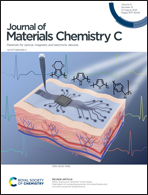Tailoring the lateral size of two-dimensional silicon nanomaterials to produce highly stable and efficient deep-blue emissive silicene-like quantum dots†
Abstract
Light-emitting silicon nanomaterials are actively pursued to exploit their photonic applications. However, the preparation of efficient blue emissive silicon nanomaterials has remained a challenge because of the difficulties in controlling the ultrasmall diameter and passivating the large-area surface of the nanomaterials. Here, we report highly stable deep-blue emissive silicene-like quantum dots (silicene-like QDs) with a photoluminescence quantum yield of above 70%, representing the most efficient blue emissive silicon nanomaterial. The new structure of the silicene-like QDs that possesses a two-dimensional silicon backbone with a reduced lateral size provides a feasible way to enhance the quantum confinement effect. A method of hydrofluoric acid etching enables the preparation of this new structure, which simultaneously reduces defect density of the silicene-like QDs and thus enhances radiative recombination of electron–hole pairs. Furthermore, we demonstrate a deep-blue emissive LED based on the silicene-like QDs, showing a maximum luminance of larger than 2000 cd m−2. Our results open the door towards the silicene-like QDs as outstanding optical and optoelectronic materials.



 Please wait while we load your content...
Please wait while we load your content...